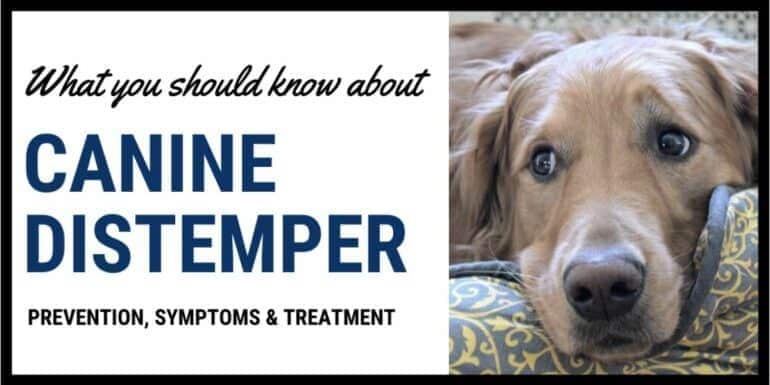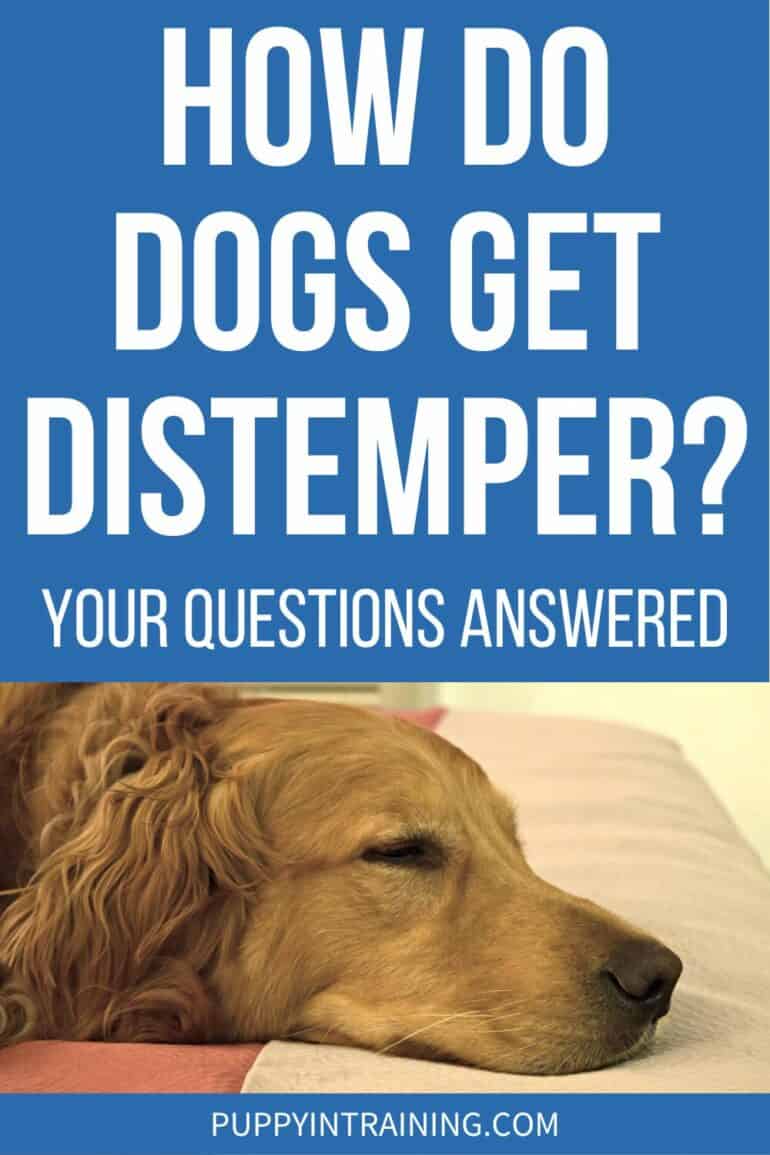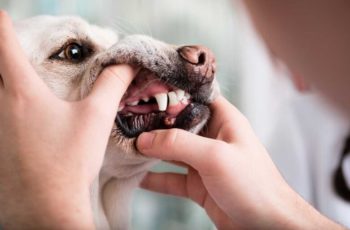This post may contain affiliate links. We may earn money or products from the companies mentioned in this post.
Has your dog ever gotten canine distemper?
We’ve been lucky…knock on wood…we’ve raised, puppy sat, and trained hundreds of dogs and we haven’t had to deal with canine distemper.
Today, we’re going to cover the questions: how do dogs get distemper and what you should do if your dog does (get it).

UPDATE: This post was published on MyDogLikes (originally on Animal Bliss) on February 8th, 2022. We recently updated and republished here on PuppyInTraining.com.
DISCLAIMER: We are not veterinarians. If your dog has any health issues then please contact your vet as soon as possible. This article is for entertainment purposes only.
If you have a dog, you’ve at least heard the word “distemper” and know it’s a bad thing for your dog to have.
But what is it exactly?
How do dogs get distemper?
What can we do to prevent it?
How is it treated and is it curable?
Frequently Asked Questions About Canine Distemper
What is Canine Distemper?
Canine distemper is a serious, highly contagious, viral illness with no known cure.
The virus attacks the respiratory, gastrointestinal, and nervous system.
The disease affects dogs, and certain species of wildlife, such as raccoons, wolves, foxes, mink, and skunks.
The common house pet, the ferret, is also a carrier of this virus. Canine distemper is related to the human measles virus.
Young puppies and adolescent dogs who are unvaccinated, as well as non-immunized older dogs tend to be more susceptible to the disease.
How do Dogs get Distemper? Is it Contagious?
Yes! The virus highly contagious and is spread through the air and by direct or indirect contact with an infected animal.
Direct contact would include contact with fresh urine, blood or saliva. Indirect contact would be through bedding, bowls, toys, etc.
The most common way it is caught is by breathing in particles secreted by infected dogs.
What are the Symptoms of Canine Distemper?
Canine distemper initially attacks a dog’s tonsils and and replicates itself there for about one week.
It then attacks the respiratory, urogenital, gastrointestinal, and nervous systems.
The dog will appear normal and healthy for several days after coming in contact with the virus.
They will then shows symptoms of sneezing, coughing and thick mucus coming from the eyes and nose.
The dog will experience high fever (103.5 ° F, or 39.7° C), lethargy, and sudden vomiting.
Over the next couple of days the dog will develop diarrhea, depression and/or loss of appetite, usually leading to anorexia.
After about four weeks, the virus starts attacking the other systems of the dog’s body, particularly the nervous system.
The brain and spinal cord are affected and the dog may start having fits, seizures, paralysis, and attacks of hysteria.
The seizures are often so violent that euthanasia is often the most humane thing to do.
In dogs or animals with weak immune systems, death may result two to five weeks after the initial infection.

What Should I Do if my Dog Shows Symptoms?
See a veterinarian immediately!
The virus spreads rapidly and must be aggressively treated as soon as it’s discovered.
How is Canine Distemper Diagnosed?
Diagnosis of this disease is done through biochemical tests and urine analysis. X-rays may be necessary to determine if the dog has contracted pneumonia.
What Can I do to Prevent Canine Distemper?
The best thing to do is to have your dog properly immunized against this disease. For a puppy, make sure he gets his first vaccination at six to eight weeks of age.
Be sure to keep him away from any possibly infectious dogs or environments until he’s finished with his vaccinations at four or five months old.
Immunization is very effective and especially important if your dog is around other animals.
What is the Cure for Canine Distemper?
At this time, there is no cure for the actual virus that causes Canine Distemper.
Treatment consists of controlling the spread of the virus and severity of secondary symptoms such as vomiting and diarrhea.
Constant care is needed to make your dog as comfortable as possible.
Intravenous fluids may be given to prevent dehydration and antibiotics to ward off secondary infections while the infected dog builds up his immune response.
Some dogs are able to survive the infection, while for others canine distemper can be fatal.
Dogs who recover from canine distemper may have seizures or other central nervous system disorders that may not show up until many years later, sometimes in their old age.
They may also be left with permanent brain and nerve damage, and these symptoms also may not show up until years later.
Final Thoughts
Sorry to be such a downer today but it’s important for you to know about some of the dangers out there for your pup.
If you haven’t seen our article on puppies and parvo then advise you check it out immediately.
Hopefully, you won’t have to deal with any of these deadly diseases. If your dog is showing any symptoms contact your vet immediately.
I hope you’re dogs are doing well. If you have any experiences with canine distemper please let us know any tips on prevention and treatment in the comment section below.
Save To Pinterest

Top Picks For Our Puppies
- BEST PUPPY TOY
We Like: Calmeroos Puppy Toy w/ Heartbeat and Heat Packs – Perfect for new puppies. Helps ease anxiety in their new home. - BEST DOG CHEW
We Like: Mighty Paw Naturals Bully Sticks – All of our puppies love to bite, nip, and chew. We love using Bully Sticks to help divert these unwanted behaviors. - BEST DOG TREATS
We Like: Crazy Dog Train-Me Treats – We use these as our high-value treats for our guide dog puppies. - BEST FRESH DOG FOOD
We Like: The Farmer’s Dog – A couple months ago we started feeding Raven fresh dog food and she loves it! Get 50% off your first order of The Farmer’s Dog.
Check out more of our favorites on our New Puppy Checklist.


